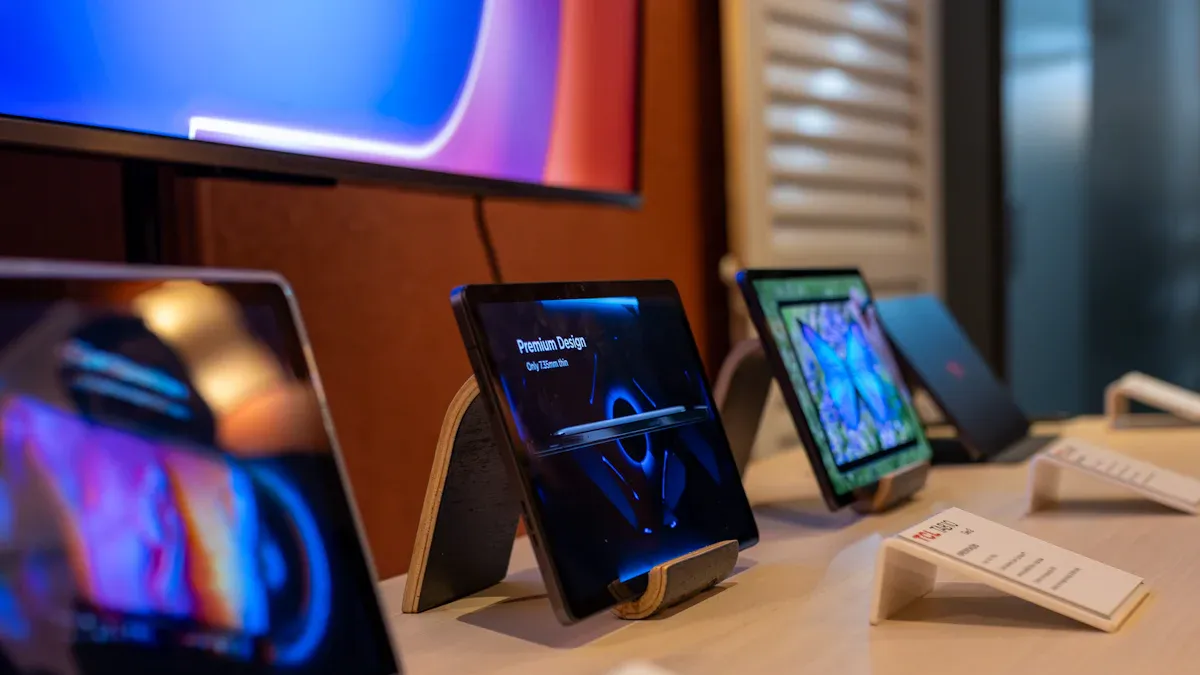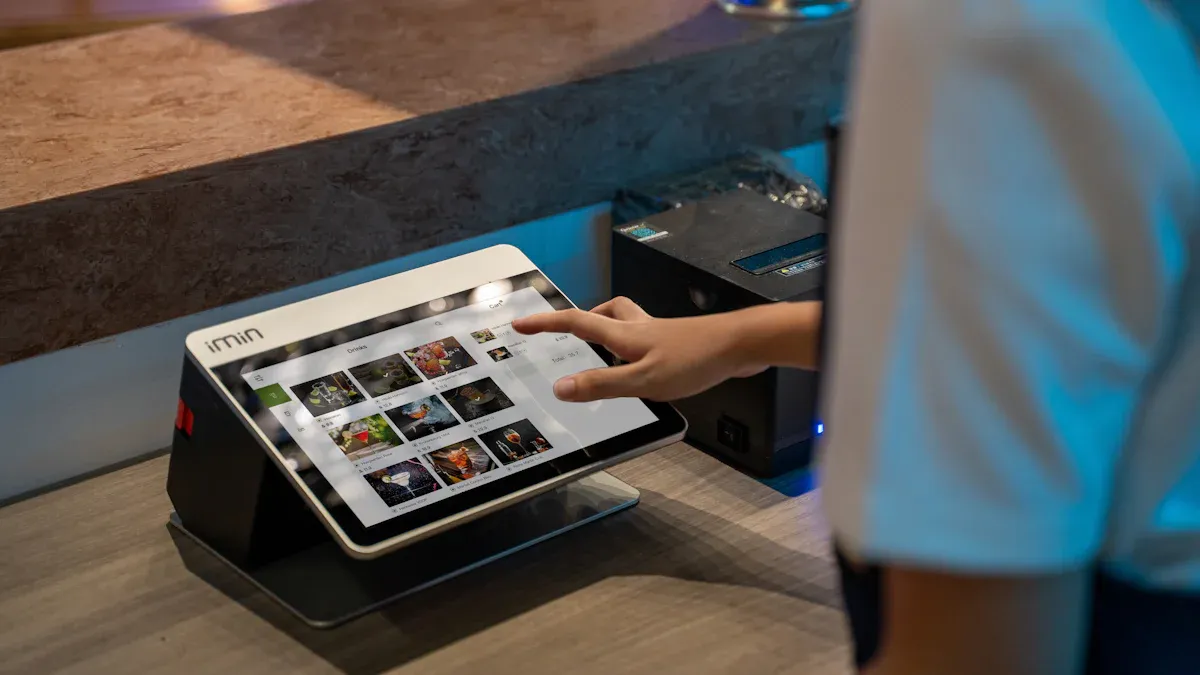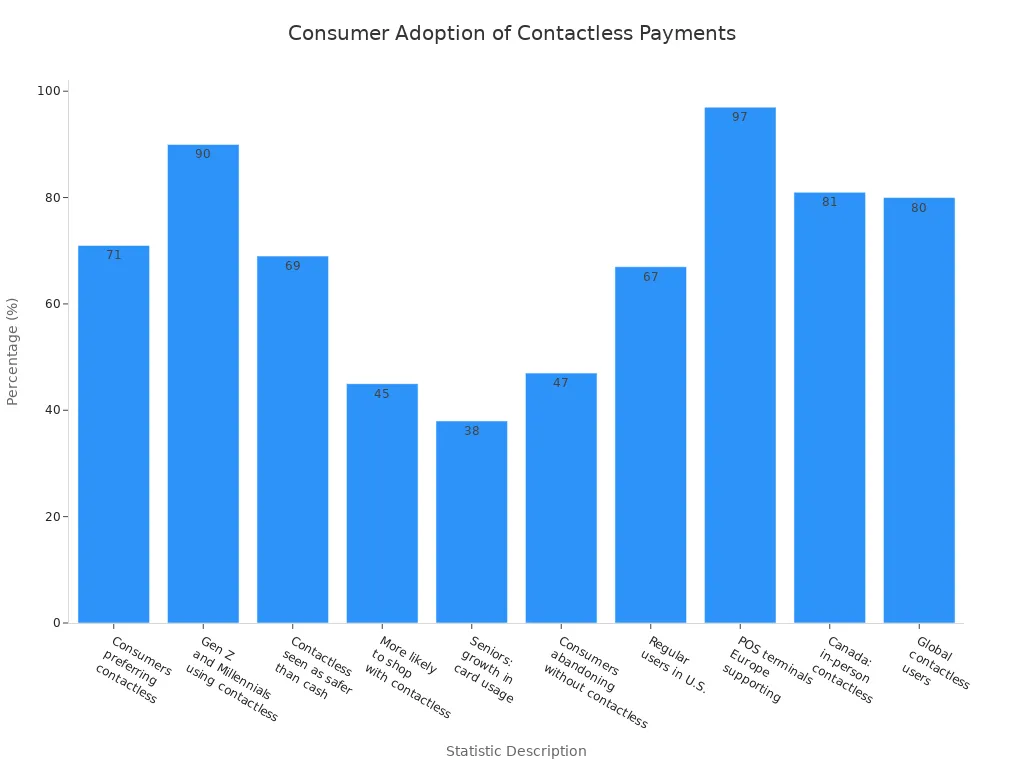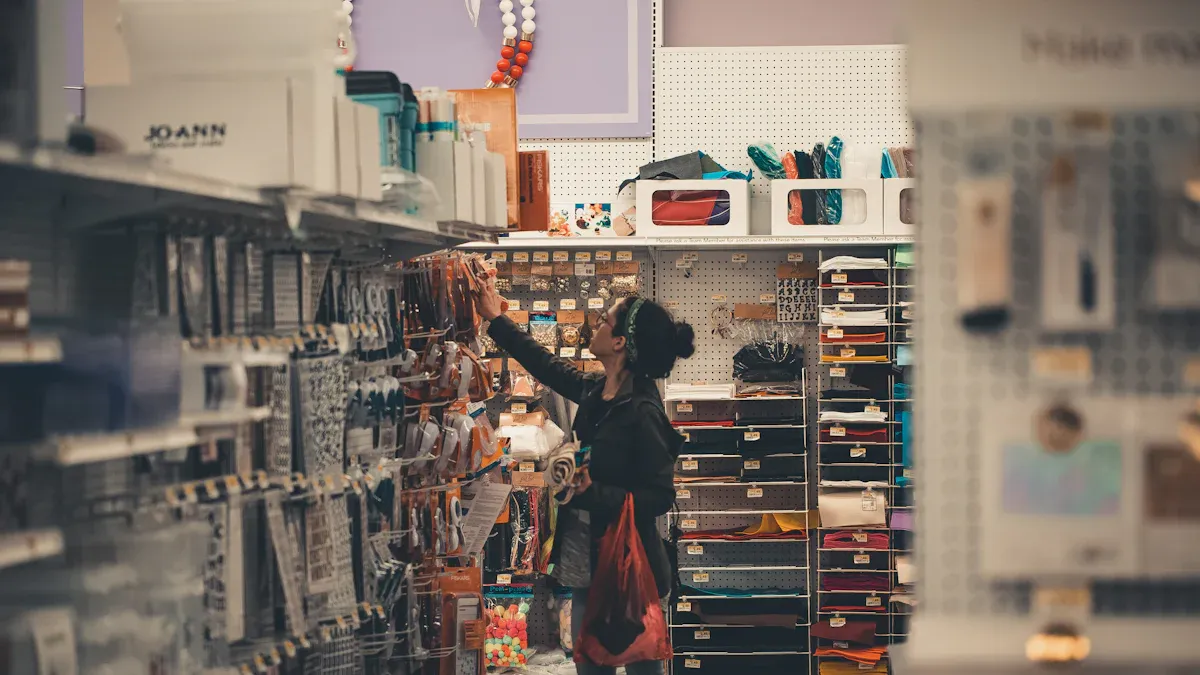What’s Next for Consumer Experience in AI-Powered Retail in 2025

AI is changing how people shop in convenience stores, significantly enhancing the consumer experience. Shoppers want faster checkouts and more special deals, along with shelves filled with what they need. In 2025, shopping will continue to evolve as more stores implement AI. Many companies are already utilizing AI, with about 71% of them adopting it now. Most, or 92%, set up new AI systems in less than a year, demonstrating a strong commitment to improving the consumer experience. Experts predict that AI in grocery stores will grow by 400% next year.
Statistic | Value |
|---|---|
Companies using AI | 71% |
AI deployment time | 12 months or less for 92% |
Expected growth in AI grocery deployments by 2025 | 400% |
Executive commitment to AI in grocery | 86% |
AI-powered checkout systems quickly identify items and simplify age checks, enhancing the consumer experience for everyone. Special suggestions help stores increase sales and encourage customer loyalty. Smart forecasting enables stores to know what to stock, reducing waste and ensuring products are readily available.
Key Takeaways
AI helps shoppers by giving them product ideas that fit them. This makes customers feel special and want to come back to the store.
Automated checkout lets people pay fast. It helps shoppers spend less time waiting in line.
AI keeps track of items in the store all the time. Shelves stay full of things people like. This makes customers happy.
Shoppers like contactless payment because it is quick and safe. Fast and safe payments make people want to shop again.
Unmanned stores are getting more popular because they are easy to use. They give fast service and make shopping simple.
AI and Consumer Experience
Personalized Shopping Journeys
AI is changing how people shop in convenience stores. Shoppers now get product suggestions that fit what they like. Stores use AI-powered engines to look at what people buy. These engines suggest snacks or drinks customers might enjoy. For example, Punchh helps Stinker Stores study snack-buying habits and give personal ideas. Zippin’s computer vision lets people grab items and pay without waiting in line.
Retailers use AI to make shopping feel special for each person. Walmart’s virtual store, Walmart Realm, gives content and suggestions based on what users like. Amazon’s dynamic pricing engines change prices quickly. This makes shopping more fun and helps people find deals. These changes help shoppers feel important and make them want to return.
Did you know? 80% of shoppers are more likely to buy from brands that give personal experiences. Companies that are good at personalization make 40% more money than others.
Stores get big rewards from personalization. Personalization can raise revenue by up to 15%. It can also make customers happier by up to 20%. Retailers using AI saw sales go up by 2.3 times and profits rise by 2.5 times compared to stores without AI. Most retail leaders think they will have AI by 2025 to make shopping more personal.
Efficient Service Delivery
AI helps convenience stores serve people faster and better. Smart shopping assistants answer questions and help shoppers find things. AI tools make back-office work easier and help stores run better. Retailers use AI to study data and make smarter choices about prices and stock.
Automated checkout makes buying things quick and easy. Stores like Loop Neighbor Markets use smart tools to stop loss and work better. Fav Trip uses AI to watch shelf restocking and stop shoplifting. This helps keep shelves full and shoppers happy.
Convenience Store Chain | Measurable Gains | |
|---|---|---|
Loop Neighbor Markets | Advanced monitoring tools to reduce shrink | Significant shrink reduction |
Fav Trip | AI to deter shoplifting and track shelf restocking needs | Improved inventory management |
AI video analytics spot strange actions right away. These systems watch store cameras and see odd moves near expensive items. AI can even notice theft before it happens, making stores safer for everyone.
Retailers using generative AI tools like chatbots on Black Friday saw a 15% better conversion rate. 60% of retail buyers said AI tools helped with demand forecasting and inventory in 2024. AI is very important for meeting new shopper needs and gives stores an edge in a fast-changing market.
Tip: Automated checkout and smart assistants make shopping faster and easier, making the consumer experience better.
AI helps stores manage stock, improve how they work, and give better service. These new tools make shopping smoother and more fun for everyone.
Frictionless Checkout

Frictionless checkout is making shopping much easier. People want to shop fast and leave quickly. Stores use AI to help with this. New technology lets customers pay without cash or cards. Sometimes, shoppers can even leave without stopping at a register.
Contactless Payment Solutions
Contactless payments are now very common. Shoppers can tap their phone or card to pay. This makes checkout faster and safer. AI helps these systems work well and keeps payments safe. Most people like contactless payments because they save time. Many think it is safer than using cash.

Statistic Description | Percentage/Value |
|---|---|
Consumers preferring contactless payments | 71% |
Gen Z and Millennials using contactless payments | 90% |
Consumers believing contactless is safer than cash | 69% |
Customers more likely to shop at retailers with contactless options | 45% |
Consumers abandoning purchases without contactless options | 47% |
Regular users of contactless payments in the U.S. | 67% |
AI-powered payment systems do more than speed up checkout. They help stop fraud and protect shoppers’ information. Many people want better fraud protection. AI can find problems before they happen. Almost three out of four shoppers want stores to offer better security.
Contactless shopping is changing how we shop. It is fast, safe, and easy. Stores that keep shoppers safe earn trust. Trust makes people want to come back.
71% of shoppers want better fraud protection in 2025.
26% like AI payment systems for faster checkouts.
43% think flexible payments are very important.
Automated Entry and Exit
AI is also making it easier to enter and leave stores. Some stores let people walk in, grab what they want, and walk out. Amazon’s cashierless shopping is one example. Other stores use scan-and-go checkouts. These are good for people in a hurry.
Fully-automated checkout uses computer vision for easy shopping.
Autonomous stores use cameras and smart shelves to track products.
These systems help stores work better and keep shoppers happy. They make wait times shorter and shopping smoother. Stores save money and can help customers more.
Aspect | Impact on Wait Times and Security |
|---|---|
Operational Efficiency | Shorter wait times mean staff can help customers more. |
Cost Reduction | Stores save money and can spend more on safety. |
Enhanced Customer Experience | Shopping is smooth and safe, so people enjoy it more. |
Reduction in Human Error | Fewer mistakes make shopping faster and safer. |
AI-powered entry and exit systems make shopping quick, safe, and fun for everyone.
Smart Inventory Management
Real-Time Stock Updates
AI is changing how stores track products. Stores now use smart systems to watch inventory all the time. These systems notice empty shelves and tell workers right away. Shoppers see full shelves more often. Stores do not run out of popular items as much.
AI forecasting can lower empty shelf times by 65%. Stores keep more things in stock, so shoppers find what they want.
AI looks at old sales, seasons, deals, and other things. This helps stores guess what people will buy very well.
Companies using AI for inventory say they have 20–30% less stock but still serve customers well.
When stores use AI with RFID and IoT, they see stock levels in real time. Workers can fix problems fast.
Stores also save money. McKinsey says AI can cut inventory costs by 20% and lower stockouts by 50%. Workers spend less time counting items. They help customers more. Stores work better and shoppers are happier.
Tip: Real-time stock updates mean shelves are full and restocked fast. Shoppers get what they need, and stores waste less.
Predictive Demand Analysis
Predictive demand analysis helps stores know what people will buy next. AI studies old sales and market trends. It finds patterns and helps stores order the right amount. Stores use different tools for this:
Tool Type | Description |
|---|---|
Automated Predictive Inventory | Uses predictive analytics to help with demand and inventory. |
Vendor Managed Inventory Solutions | Supplier manages inventory but may not use all data for good forecasts. |
Market Basket Analysis Solutions | Looks at what people buy together but does not guess future demand. |
Supply Chain Planning Software | Uses lots of data to help stores guess what to order, making it a strong tool. |
Retail demand forecasting can lower inventory costs by 15-25%. New AI tools can guess demand with 75-90% accuracy. AI can cut mistakes in forecasts by 50%. Stores make fewer supply chain errors and have better inventory. Profit margins can go up by 5-10%.
Idaho Forest Group used AI to cut forecast time from 80 hours to 15 hours. Stores using predictive analytics do better than others. They fill shelves with what shoppers want and do not waste money on extra stock.
Note: Predictive demand analysis helps stores plan ahead. Shoppers find what they need, and stores make more money.
Security and Privacy
AI Video Analytics
Retailers use AI video analytics to help keep stores safe. These smart systems watch video feeds and look for trouble. They send alerts right away if they see something odd. For example, they notice movement in off-limits areas or strange actions near pricey items. Store managers get these alerts fast and can act quickly.
AI works with cameras to spot threats as they happen.
Predictive analytics help stores know when problems might come up.
These systems make finding threats easier and more accurate.
AI video analytics can tell normal actions from suspicious ones. If someone hangs around valuable things or moves oddly, the system warns staff. Security teams get these warnings and can help right away. AI also helps cut down on false alarms. This means staff can focus on real issues, not mistakes.
Tip: Stores using AI video analytics have less theft and better safety. Real-time alerts help security teams stop problems before they start.
Data Protection Measures
Protecting customer data is very important in AI-powered retail. Stores use strong tools like encryption and access controls to keep data safe. AI watches for strange activity and blocks people who should not get in. Retailers must follow rules like CCPA and GDPR. These rules give shoppers rights over their own data.
AI sorts and protects lots of data, helping stores follow privacy laws.
Systems learn about new rules and help stores update their policies.
Stores must be honest about how they use data and tell customers what they collect.
Top convenience store chains care about handling data the right way. They show shoppers how their data is used and kept safe. Regular checks help stores keep up with privacy rules. These steps make shoppers feel safe and want to come back.
Data Protection Steps | Description |
|---|---|
Encryption | Scrambles data to keep it safe |
Access Controls | Limits who can see sensitive information |
Compliance Audits | Checks if stores follow privacy laws |
Transparent Data Practices | Tells shoppers how their data is used |
Note: Good data protection builds trust and keeps shoppers safe as AI changes retail.
Digital-Physical Integration
Digital tools now mix with shopping in stores. Shoppers use phones and smart devices to make shopping easier. Retailers want these worlds to connect for a smooth experience.
Mobile Apps and Virtual Assistants
Mobile apps and virtual assistants help shoppers in many ways. People want to switch between online and store shopping easily. Stores use digital tools to make customers happier and help them buy things.
Many stores have apps that guide shoppers and show product info.
Apps let people check out fast and see what is in stock.
Personal suggestions pop up based on what shoppers do.
Chevron ExtraMile stores use an AI assistant named Sam the Sommelier. He gives wine tips by voice or chat in the app. Shoppers can take a quiz to find their best wine and buy it without talking to a cashier. These tools make shopping feel easy and personal.
Mobile apps and virtual assistants help shoppers start searching at home and finish in the store. This makes shopping smoother and more connected.
Augmented Reality Features
Augmented reality (AR) brings new fun to stores. Shoppers use phones to get special deals and find products in cool ways.
Application | Technology to Use | Retailer Benefit |
|---|---|---|
Augmented Reality (AR) | Makes shopping more fun and keeps shoppers in the store longer. Shoppers follow clues, win prizes, and find new items. | |
Endless Aisle / Virtual Showroom | Augmented Reality (AR) | Shows all products, even ones not in stock. Shoppers look at and interact with more items. |
AR mirrors let people try on clothes or accessories virtually. Shoppers feel sure about their choices when they see how things look. They are more likely to buy things they can "try out" first. AR also helps lower returns because customers know what to expect.
AR makes shopping more fun and interactive.
Shoppers find new products and feel good about their choices.
AR features make shopping an adventure. Shoppers like exploring, and stores sell more.
Unmanned Store Experience

Meeting Consumer Expectations
Unmanned convenience stores are opening in more places. Shoppers want fast service and easy shopping. These stores use AI to make shopping simple. People walk in, pick what they need, and leave fast. There are no lines or waiting for a cashier. Cashier-less technology makes checkout quick and easy. AI systems can see many items at once, so paying is faster.
AI also helps keep shelves full. It guesses what people will buy and keeps products ready. Shoppers see fewer empty shelves and find what they want. This makes people want to come back again. Many shoppers want stores open all day and night. This fits busy lives. Online shopping is growing, so stores add automated options. Shoppers want safe and smooth trips, so unmanned stores focus on user experience and safety.
Tip: Unmanned stores use smart tools to give shoppers speed, safety, and easy shopping.
What makes unmanned stores popular?
Faster service and lower prices
Easy shopping with new technology
Open all day for busy people
Focus on safety and good user experience
Operational Challenges
Retailers have some problems with unmanned stores. Technology costs a lot and is hard to set up. Each store must follow different local rules. Security is a big worry for stores. They need strong systems to stop theft and protect data. Some shoppers worry about how their data is used, especially with facial recognition.
Challenge Type | Description |
|---|---|
Technological Barriers | Problems with old systems and high costs for new technology. |
Regulatory Compliance | Stores must follow different rules in each place. |
Security | Worries about safety, data protection, and stopping theft in unmanned stores. |
Consumer Trust | Concerns about using personal data and trusting technology like facial recognition. |
Retailers must use new technology and keep shoppers’ trust. They work to keep stores safe and follow privacy rules. When stores fix these problems, shopping gets better for everyone.
Future Trends and Opportunities
Evolving Consumer Behavior
Shoppers are always changing how they shop. They want stores to know what they like. They want products that fit their needs. AI helps stores give each person a special shopping trip. People hope stores remember their favorite snacks or drinks. They also want stores to suggest new things to try. Retailers use AI to watch what shoppers do. This helps them make better choices every day.
Here are some big trends shaping how people shop:
Trend | Description |
|---|---|
Personalization at Scale | AI lets stores match shopping to each person’s style and taste. |
AI-Powered Retail Optimization | Stores use AI to study data and make smart choices fast. |
Integration in Supply Chain | AI helps stores manage products better, so shelves stay full and costs go down. |
Shoppers want more personal deals and offers.
AI helps stores give custom ideas and change prices fast.
Retailers try to make big stores feel special for everyone.
AI gives stores real-time information. They see what people buy and what is popular. This helps stores keep up with trends. It also makes shopping better for everyone.
Growth Potential for Retailers
Retailers can grow a lot when they use AI. Stores that use AI sell more and make more money. Some stores see sales go up by 2.3 times. Profits can rise by 2.5 times compared to stores without AI. More than half of stores using AI get over 10% back on what they spend. About one in five see gains of more than 30%.
AI helps stores work faster and smarter.
Retailers save money by stocking the right things.
Stores can give better service and keep shoppers coming back.
AI-powered tools help stores meet new needs and make shopping better. The future looks good for stores that use smart technology. They can grow faster and help shoppers more.
Stores that use AI can expect more sales, happier customers, and a stronger place in the market.
AI is making shopping different. People get help faster and find deals just for them. Stores are safer because of smart technology. Retailers use new tools to make shopping simple and fun.
AI lets workers spend more time helping shoppers.
Stores give easy shopping and more options.
Young people use AI a lot, especially to learn about products.
Shopping will keep getting better. AI will make stores easier and more connected for everyone.
FAQ
What is AI-powered retail?
AI-powered retail uses smart computers to help stores work well. These computers suggest products for shoppers. They also keep track of items in the store. Checkout is faster because of AI. Shoppers have an easier time in stores.
How does AI make shopping more personal?
AI looks at what people buy and what they like. Stores use this to give deals and suggest products. Shoppers see things that fit their style. They find items that match what they want.
Tip: Personalized shopping helps people find new things. It also saves time for shoppers.
Are unmanned stores safe for shoppers?
Unmanned stores use cameras and AI to watch for problems. They keep shoppers safe and protect products. Stores use strong tools to keep data safe.
Safety Feature | What It Does |
|---|---|
AI Video Analytics | Finds theft or danger |
Data Encryption | Keeps information safe |
Will AI replace store workers?
AI helps workers do their jobs better. It does tasks like checkout and stocking shelves. Workers spend more time helping shoppers. They also solve problems in the store.
AI helps staff do their work.
Shoppers still see friendly faces in stores.
See Also
The Future of Retail Lies in AI-Driven Stores
Understanding the Growth of AI-Enhanced Corner Stores
Transforming Online Retail Management with AI Tools
